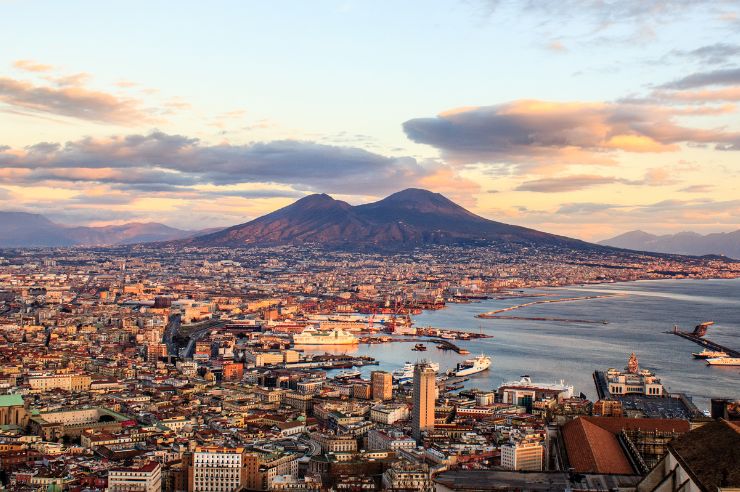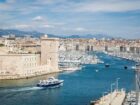Wondering whether to choose Sorrento or Naples as your base for a few days in Southern Italy? This article will definitely help you make a decision!
Naples is the third-largest city in Italy with a population of 3 million, located on the west coast of southern Italy overlooking the Tyrrhenian Sea, in the shadow of Mount Vesuvius. The city is full of life and energy. Its historic center is a UNESCO World Heritage site. Although a little rough around the edges, Naples offers warmth and authenticity to the visitor.
Sorrento is a picturesque town located on the Sorrentine Peninsula in Southern Italy, overlooking the Bay of Naples. It has stunning natural beauty with dramatic cliffs, crystal-clear waters, and colorful buildings cascading down the hillsides. The charming old town is full of narrow alleyways, quaint shops, and traditional trattorias. It is a great base for exploring the Amalfi Coast and Pompeii.
For a vibrant, authentic city experience with stunning architecture and museums, great traditional cuisine, and exciting nightlife, choose Naples. For a more tranquil, pretty, smaller tourist-friendly town with amazing views and easier access to the Amalfi Coast and Pompeii, choose Sorrento.
See also:
Sorrento or Capri for short stay
Sorrento Or Salerno for a short stay
Sorrento Or Positano for a short stay
What travelers say
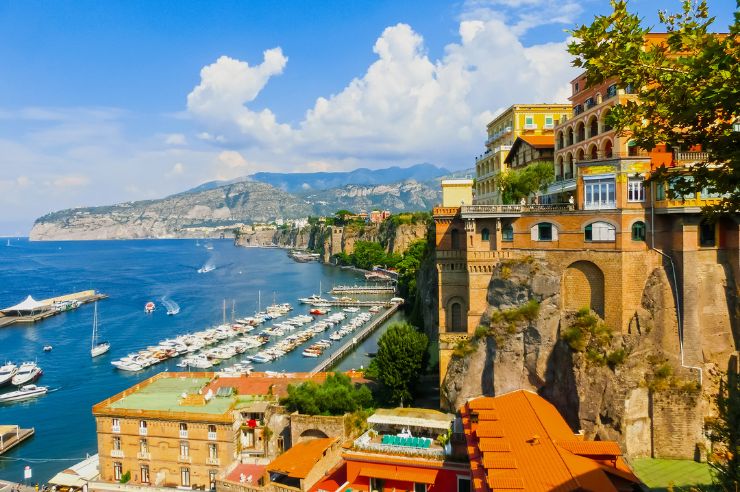
- Naples provides a different charm compared to Sorrento. It is far bigger and has grit, character, and bustling metropolis energy. Buildings and structures are authentically rustic and worn.
- In Naples, tourists visit museums and sights dating from the 7th century B.C. up to the modern era.
- Sorrento is first and foremost a nice coastal holiday resort town with lots of vacationers (including many Brits). It’s typically packed with tourists in the high season (May to October).
- While Sorrento is a nice tourist town, it’s an attractive town with a history going back over 2000 years. Travelers often choose it as a starting point for visiting Capri and Amalfi Coast towns.
- Sorrento is always buzzing with tourists and can be a lot more expensive, but has a safer feel than Naples.
- Sorrento has spectacular views of Vesuvius and lots of bars, restaurants, and shops. It also has some great and reasonably-priced hotels.
- Most people find there is a lot to do in and around Sorrento. It has a busy main street, great for people-watching. It also has lots of small boutiques and tourist shops.
- In Sorrento, the old town is up on the hillside, so walking to and from the marina or up to the train station requires steep climbs, or taking the elevator (doesn’t work in the winter months) or bus.
- While Sorrento is on the coast, it has no proper seafront or beaches. Some higher-end hotels on the cliffs offer swimming platforms – wooden decks that can be reached via an elevator.
- Naples is better if you’re an independent traveler, while Sorrento is better suited for trips on the Amalfi Drive or to Capri.
Getting around
Sorrento, which is 50km (31 miles) south of Naples, can be reached easily via public transport. There is a Curreri Viaggi bus which takes an hour from Naples Capodichino airport and costs €10.
The Circumvesuviana train is faster and cheaper. It runs from Naples to Sorrento and takes anything from 45 minutes up to 1 hour and 15 minutes at a cost of €6-€11. The Circumvesuviana train from Naples to Sorrento stops on the way at Pompeii and Herculaneum.
A more scenic and relaxing way to arrive is to take the Naples to Sorrento ferry which departs from the Molo Beverello pier.
Sorrento offers easy connections to all the spots that tourists want to visit, including the Amalfi Coast, Capri, Naples, Pompeii, and Herculaneum.
In Sorrento, a bus takes you from the Piazza to the harbor for about a euro.
From the Sorrento Port, you can take a hydrofoil to Capri, Ischia, and Naples and you can take a boat to Amalfi Town. The ferries cost around € 20 pp each way between Sorrento and places like Capri.
You can visit the Amalfi Coast from Sorrento by taking a bus. You can also consider driving, however it won’t be a relaxing drive in summer and you might not be able to stop for pictures. From June through September, the roads are often gridlocked, and you have to wait in long lines for buses and ferries.
Some travelers stay in Sorrento and use the services of a private driver to visit Pompeii, Capri, Ischia, Vesuvio, and the Amalfi Coast. You can check out HSE Drive for well-rated driver services
NOTE: if you need to store your luggage before checking in or after checking out of your hotel, you can use Radical’s convenient storage service locations in Naples.
Vibe & people
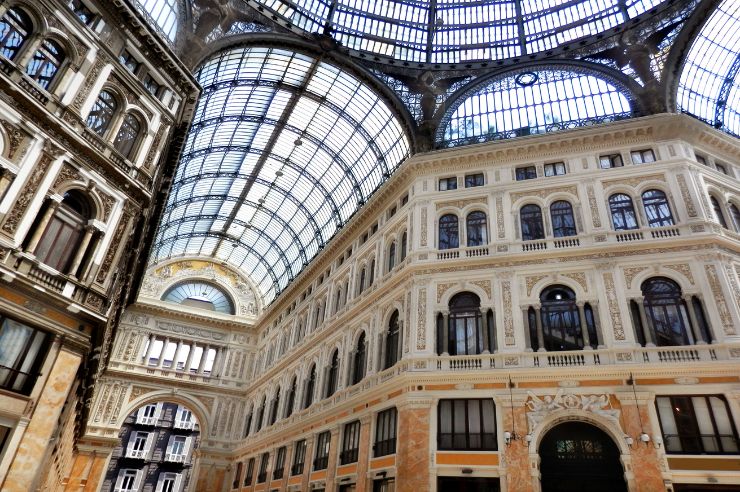
Naples
Naples is very eclectic and truly diverse, which makes it so special. It is filled with energy and color, creating what can only be described as fun and somewhat chaotic.
You can find beauty in its range of piazzas, outdoor sculptures, fountains, churches, infrastructure, ancient castles, and its crystal blue sea. There is an excellent waterfront promenade, miles long, and lovely views over the bay and Vesuvius
Travelers love Naples because it has fantastic sites, far fewer tourists than Sorrento, and more locals to display the vibe and social scene of the city.
On the flip side, the streets are often crammed with traffic and the urban feel might be off-putting for some, such as the graffiti displayed throughout the city. For some, it’s art and social commentary, for others it’s disruptive.
Naples is slightly under the radar for tourists mainly because it isn’t as organized as Sorrento. It is its own life form and doesn’t exist for tourism. It offers a peek into what Italian cities might have looked like generations ago. It is an escape from the ever-moving, ever-modern European world.
Although many people are overall fans of Naples and recommend the visit, there are some cons. The city can be dirty. The air is polluted and the streets can be littered. Do not expect great restaurant service or a warm smile from locals on the street.
But, as long as you have thick skin this should not get in the way of you fully appreciating Naples and all it can offer. If your time allows, take about three days to discover the city fully. You might need more time to ease into the fast pace and let the beauty sink in.
Sorrento
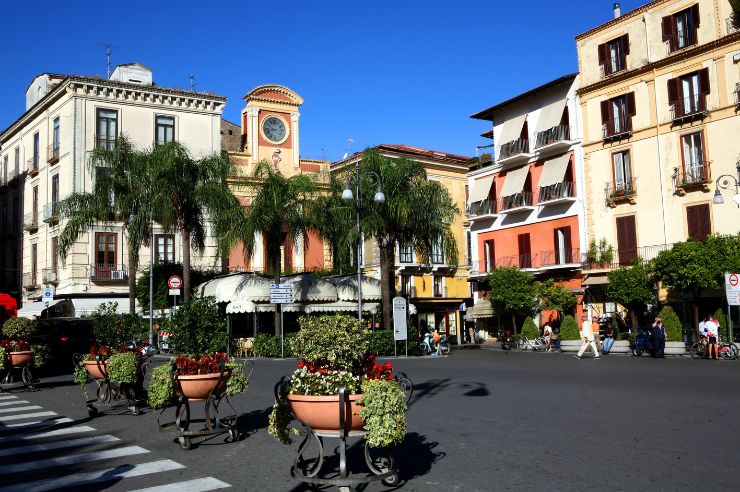
Sorrento is a decent-sized tourist town with plenty of bars, restaurants, and some clubs. There is a historic central Piazza and nice pedestrianized areas, a working fishing harbor, a modern shopping area, and ancient streets.
Sorrento has great views, good food, sunsets, piazzas, lemon, and shopping. Many visitors enjoy the experience despite the thousands of tourists around them in the summer.
In Sorrento, the sun sets behind the looming cliffs and it goes into shadow in the evening. Locals enjoy being seen out for a walk and enjoying an aperitif or an espresso.
The town is alive with tourists at night, when people return to their hotels from their explorations during the day. In the peak season, there are numerous festivals and events.
In general, the entire Amalfi Coast is incredibly crowded in summer with horrendous traffic jams that lengthen traveling time. The same goes for the Easter holidays.
The weather in the area gets extremely hot in June, July, and August, It can make visits to Naples, Pompeii, and Herculaneum very sticky and busy.
Even in the off-season months (e.g. March), Sorrento still has more tourist activity than other locations on the peninsula.
Things to see and do
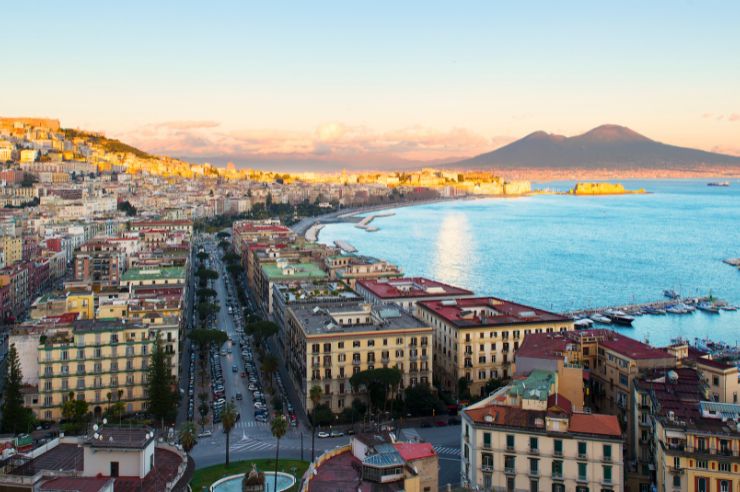
Naples
Again, Naples is sprawling, so you will have to move around to see the monuments rather than jump from short distances in a central location.
For example, it takes a little bit longer to travel between the Royal Palace of Caserta to Pompeii to Amalfi. Make sure you are planning enough time accordingly to hop from place to place.
Naples’ city center is a UNESCO World Heritage site with buildings dating back to 480 B.C. There are massively structured castles, royal palaces, and other dominating cathedrals in the area.
Naples’ Old Quarter is home to beautiful Baroque architecture and museums like the Capella Sansevero which features the famous statue “The Veiled Christ”. Sometimes, tourists miss these hidden gems.
We highly recommend the archeological museum in Naples- The Museo Archeologico Nazionale di Napoli– for a trip back in time and the discovery of some dinosaur bones.
If you choose to stay in Sorrento, a day trip to Naples should probably include these notable sights:
- Via Toledo
- Via Dei Tibunali
- The San Domenico Maggiore and Sotteranea churches
- Via Duomo
- The Royal Palace
- The Plebiscito Square
- Mascho Angiono Castle.
- Castel dell’Ovo (medieval fortress)
You can have lunch at Pizzeria da Michele near the train station, and coffee at Gambrinus. You can optionally take a boat back to Sorrento.
Check out the list of activities and tours in Sorrento.
Sorrento
Travelers often spend a day or two exploring Sorrento and its alleys, markets, and cafés around Piazza Tasso serving fresh-squeezed orange juice and cappuccino.
The citrus groves, and Villa Massa, the largest producer of Limoncello in the world, are popular visits.
Take a stroll along the Marina Grande, a pretty fishing village of days gone by – it is a rewarding excursion with a more local feel to the rest of Sorrento.
The Old Town has plenty of winding streets to get lost in amongst the giant lemons and tourist trinkets. You are never far away from a gelato, a coffee or a Limoncello.
The Chiesa di San Francisco in the historic center is a beautiful 14th-century church. The town also has other remarkable historic buildings such as the Cathedral, Basilica of Sant’Antonio and the Cloister of San Francesco.
The Museo Corrale exhibits paintings and art in an 18th-century villa with beautiful gardens and overlooking the Gulf of Naples.
Villa Fiorentino and Villa Comunale are impressive early 20th-century mansions with art exhibitions, ample green parks, and scenic bay views.
There is not much of a beach in Sorrento. However, you can head down the steep road to the Marina Grande harbor where you’ll find plenty of small seafood restaurants.
Check out the list of activities and tours in Sorrento.
Food & nightlife

Naples
Pizza is a must-try dish in Naples as it originated in this city. You can visit famous pizzerias such as Da Michele or Sorbillo. You can also take a pizza-making class to learn how to make your own.
Seafood is also a prominent part of Neapolitan cuisine. Try spaghetti alle vongole (spaghetti with clams) or frittura di pesce (mixed fried seafood).
If you have a sweet tooth, be sure to try the famous Neapolitan pastries, such as sfogliatelle or babà al rum.
Finally, consider taking a food tour or visiting a local market such as Mercato di Porta Nolana to fully immerse yourself in the city’s gastronomic delights (see this tour)
At night, the streets of Naples are bustling and the lively piazzas are filled with locals and visitors. One popular spot is the Piazza Bellini with its trendy bars and live music venues that attract a young trendy crowd.
The historic center of Naples also has wine bars, pubs, and clubs. The Chiaia neighborhood has more laid-back atmosphere and elegant bars and lounges with a view of the Bay of Naples.
The underground scene includes the Bourbon Tunnel which hosts concerts, exhibitions, and other events.
Sorrento
You also can’t go to Sorrento without trying the pizza, e.g. at the popular Pizzeria Da Franco.
Good restaurants in Sorrento include Il Buco (highly recommended, Michelin-starred), Caruso, and Don Alfonso. There are numerous fresh fish restaurants in the harbor. Risotto is a Sorrento specialty.
Mercato Tasso local market is worth a visit to experience fresh local produce. Another big recommendation is ice cream at Gelateria David. Lemons also grow in abundance in the area and get used in everything, biscuits, pasta, soap, sweets, and of course the famous Limoncello beverage.
Numerous food tours and cooking classes can be found in Sorrento.
Sorrento has a bit of nightlife in the high season, including a selection of bars and pubs and a few nightclubs – e.g. open-air dancing at The Foreigner’s club as well as some Napolitano shows.
Shopping
Naples
In Naples, the clothes and shoes are fairly inexpensive but always on-trend. You can find the Via Toledo, the longest shopping street in Naples, with numerous boutiques, department stores, and bigger chains.
The historic center of Naples has many small, traditional shops selling handmade pottery, leather goods, and jewelry, many of them along the famous Spaccanapoli street.
For high-end luxury shopping, the Chiaia neighborhood has designer boutiques and chic fashion houses. The Galleria Umberto I, a stunning 19th-century shopping arcade, is another luxury shopping area.
The street markets such as Poggioreale or Via San Gregorio Armeno are known for selling handmade nativity scene figurines.
Sorrento
Sorrento has an abundance of tourist souvenir shops. It’s also a great destination for leather goods and shoes. The town has great shopping every night until 9 pm.
Via San Cesareo has many shops selling fashion and limoncello liqueur. The Marina Grande has a completely different, more local feel than the old town.
Sorrento is also famous for its inlaid woodwork – boxes, frames, and trays. Another local specialty is ceramics, with many stores selling handmade pottery and majolica tiles in bright and bold colors.
The historic center of Sorrento is lined with small, traditional shops selling local products such as limoncello, olive oil, and handmade pasta.
Corso Italia, the town’s main shopping street, has trendy boutiques and shops selling fashionable clothing and accessories.
Lodging
Naples
The historical center in Naples is a great area to stay in, with hotels ranging from basic to opulent based on your budget. The location is ideal for museums and sights especially if you are only in the city for a few days.
The Decumani Hotel De Charme is a great place on the higher end, housed in a historical building with intricately decorated dining rooms and lounges.
Hotel Art Resort on the third floor of the Galleria Umberto, a great location off Via Toledo and across the street from the Teatro Di San Carlo. The hotel has good-sized rooms and a nice breakfast, and the front desk is manned all the time. The breakfast and wine room overlooks the interior of the Galleria. The area is tourist-friendly and close to the Gran Caffe Gambrinus, the Royal Palace, and Castel Nuovo. The Castel dell’Ovo is a short walk away with many restaurants.
Chiaia Hotel de Charme is also recommended – also a short walk from the Gran Caffè Gambrinus.
If you’re on a budget, Hotel Piazza Bellini is nice with its bright and airy rooms and bathrooms, and historic courtyard. It is convenient for the archaeological museum.
Sorrento
Sorrento has a wide range of accommodations to choose from. Visitors to Sorrento often recommend the following hotels.
Hotel Eden Sorrento is in a good location and for a little extra you can have a room with a view over the water. There is also a pool.
Porto Salvo is an old monastery with simple but pleasant rooms. It’s a peaceful place to relax. It is situated just outside Sorrento on the Circumvesuviana train line.
La Maison de Titty is a family-friendly B&B close to local attractions.
The town of Sant’Agnello just outside Sorrento is reasonably priced.
Hotel Caravel is 15 minutes’ walk from Sorrento and offers good value for money. The hotel has a courtesy bus to and from the main square. It offers a great pool and jacuzzi, and has easy access to a clifftop beach. The hotel is within easy reach from all public transportation.
Hotel Desiree is on the cliffs above Sorrento and has a private beach. You can book a room with a view over the Bay of Naples.
Hotel Minerva has beautiful views of the town and Vesuvius. La Tonnarella has a private beach.
Hotel Ambasciatori, highly recommended.
Many travelers recommend the Antiche Mura Hotel for its central location at the heart of the town.
Travelers often praise the Imperial Hotel Tramontano for its sea views and excellent location.
Others like the Bellevue Syrene for its views and friendly staff.
Day trips
The Amalfi coast is closer to Sorrento than Naples. You can stake a hydrofoil (in season) or a SITA bus from Sorrento to get to the Amalfi coast towns. From Naples you can take the Trenitlia to Salerno and the bus or hydrofoil (in season) to the Amalfi coast towns.
One of the most popular outings from Sorrento is to Positano by bus. The views along the 50-minute route are simply spectacular, and you can take a boat or ferry back to Sorrento for more stunning views. It takes another 50 minutes from Positano to the town of Amalfi.
Sorrento is also a good base for day trips to Capri, Pompeii, and the Amalfi Coast. You can even take a ferry to Naples.
If you are staying in Sorrento, a trip to the preserved Roman town of Pompeii is absolutely essential. Pompeii was destroyed when Mount Vesuvius erupted in 79 CE, covering it with volcanic ash which perfectly preserved what was buried beneath.
Pompeii takes 40 min to get from Naples on the cirucmvesuviana train, 30 minutes from Sorrento.
There are guided trips (about 100€) but it can also be enjoyable to lose yourself in the city with just a map to find your way round.
Herculaneum, another ancient town and archeological site, was destroyed by the same eruption but was buried by gas and rock called pyroclastic flow. The Herculaneum site is smaller and less busy than Pompeii.
You can take one of many ferries to the Isle of Capri. Ferries leave and return throughout the day. For more information: http://www.gescab.it
Check out some great day trips you can do in Sorrento and in Naples

